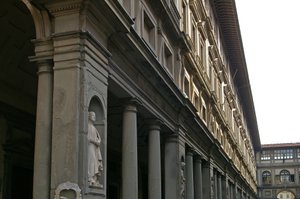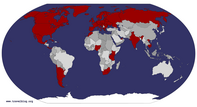Advertisement
Published: September 10th 2018

 Courtyard view of the Uffizi
Courtyard view of the Uffizi
Building so large as to be incomprehensible both inside and out(Wednesday 5:20 pm – I am writing these travel notes on the top of the tower of our hotel. Although there are clangs and bangs and a bit of traffic and horse clip-clopping from the streets far below, it is very peaceful. The birds are singing from many bell towers. At 5:00 the Duomo peeled out for several minutes. (Pause to take a couple’s photo). But it is too hot and sunny to stay longer, plus either rain clouds or heavy smog is rolling in - smells like smog. So this bit of idyll is over. There is a nice lounge downstairs.)
Our morning was focused on the
San Marco Museum, which used to be a monastery, and which contains a full cycle of frescoes by
Fra Angelico. About half are restored and the rest were under covers for their restoration. A restorer was actually working, but he was not part of the tourist attraction, so no one explained what he was doing. Fra Angelico received his name because they said he painted like an angel, his touch was so light and fine. The restored frescoes showed his beautiful shadings and skin tones.
San Marco was the monastery of
Savonarola. The second
floor held a lot of cells, each of which featured a fresco by Fra Angelico; in one corridor the paintings were virtually the same. My supposition is that his students (or similar) did them. All the topics were contemplative tableaux of the crucifixion – Fra Angelico seems to have made a study of blood spurting, because it was very realistic. As the head of the monastery, Savonarola’s cell had two rooms, one of which was a study. A bible was displayed on a desk, although neither was identified as his. The Bible had such tiny print that the reader would had to have memorized the text before myopia set in.
In the library were displays of illuminated parchment manuscripts (not as fine as those in Siena). The museum text explained that Napoleon sent all the manuscripts to French state institutions, where they still are, except for this display. Of particular interest was a case of the tools for preparation of the parchment and for writing. The tools weren’t old, but the process of preparing and writing on the parchment was explained step by step.
We had an hour or so to have some lunch and several of us

 Perseus beheaded Medusa
Perseus beheaded Medusa
Statue by Cellini on the Piazza della Signoriawent to “
I Fratellini ”, recommended by Chris. It is a tiny shop (more the size of a large closet) with a long menu of sandwiches. I ordered tuna with capers - these were the size of dimes - and the bread was fresh and warm. They asked me if I wanted it “to go”, and I said yes because I couldn’t see where “in” was. “In” was the street in front of the shop. On the wall there is a short ladder of 3” wide boards - that was the “bar” for wine or beer glasses. Every couple of inches was inscribed with a Roman numeral, presumably for guests to identify their drinks.
This brought us to our appointment at the
Uffizi Gallery – said to be the greatest in Europe. Our specialist guide, Lucca, met us at the entrance. From that moment until the end, two hours later, he hardly drew breath – lots of information on art and history delivered with infectious enthusiasm. We saw again the transformation of two dimensional, representational gothic paintings of the holy family into the very human stories from the Bible, this time through a marvellous collection of
Fra Lippi paintings and those of

 Baptistery Doors (replica)
Baptistery Doors (replica)
15 Century originals by Lorenzo Ghiberti are in the Museo dell'Opera del Duomo. His "The Birth of Venus" is beautiful, sensitive painting, but for the first time I didn’t have the thrilling emotion from seeing an original. Oddly, my favourite feature was the sea, which looked just like water – milky green, neither too still nor too tempestuous. Lucca rushed us through the centuries and all the German and Dutch masters, dismissing them with a gesture.
We stopped to admire the Uffizi building- two very long corridors (originally terraces for offices) joined by a relatively short corridor. The ceilings were frescoed with small grotesques, which were fashionable at the time. (This was because archeologists had discovered bones and statues in what were called “grottos” in Rome, although they actually were buried buildings. Somehow these were morphed into strange creatures, mixtures of animals and people, in the popular culture). Lining the walls were Roman-type statues (I have learned from our other tours that these were sometimes fake) and uniformly-styled portraits of all the then famous people of Europe, larger sizes for the
Medecis, of course.
Unfortunately, by the time we saw the Michelangelo, Raphael and Titian paintings, I and others were suffering from brain fatigue, so I actually can’t remember the
individual paintings. The visit to these exposition rooms was enjoyed in a golden fog of admiration and awe. Fortunately, one of our group remembered that “
Judith Slaying Holofernes” by
Artemisia Gentileschi, the only work by a woman in the museum, was in the
Carravagio room. “Judith” is truly an emotional painting, radiating tension and revenge – I remembered the novel I read about the painter and her tempestuous life. By going to this room, I got to see his revolutionary dramatic paintings; I am glad I saw the Carravagios in the Pitti Palace because now I am more familiar with them and remember them better).
After the Uffizi, I had a rest and then headed out to take photos, which are difficult to frame and light in the morning while touring. The afternoon sun shone full on the façade of the Duomo, beautiful, even if it is a “modern” manifestation of procrastination (facade done in 1887). In the same square, I was concentrating so hard on getting a virtually tourist-free picture of Perseus slaying Medusa, I didn’t hear one of our tour members. Later, at supper time, she told me about her silent approach and retreat.
Since I was close to
the Baptistery, I decided to go in. It was closed when Chris took us Monday morning, and he promised to refund the price of our tickets if we went on our own. He mentioned that it was a mosaic, and I was feeling rather blasé – until I stepped in. The ceiling was a high cone, covered in glittering gold and coloured elements (stones, chips, mirrors?) Sadly, the wall frescoes were mostly drowned in the 1966 flood of the Arno, but the ceiling was intact and unique - featuring a large Christ sitting on a throne and picture panels all reaching up the cone. The light was very dim so I doubt my photo efforts will be too successful, and I couldn’t find a post card, which is my usual solution.
The Straw Market, or Porcellino Market, or New Market, was not far away, so I went to have a look at the boar again. Lots of people were still rubbing its snout to a fine polish. From there it wasn’t far to the department store on the Piazza della Repubblica that was recommended by guides for both its free washrooms and its terrace garden. My roommate, Sue, suggested

 Ponte Vecchio 1345
Ponte Vecchio 1345
Originally butcher shops, now glittering jewelleryI should buy a light blouse there (mine are mostly long sleeves and not too good for this weather). The clothes on display were not my style, not my colours and about 8-9 times beyond my price preference! So I used the facilities and climbed to the rooftop terrace. In fact our hotel Torre de Guelfo has a much better view, but I ordered an espresso and enjoyed the atmosphere.
(After writing this I needed a rest and some time to do laundry in the bathroom. Thanks to the warm weather (28 – 33 C), the clothes dry fairly quickly. Chores done, I went up in the Torre again. (The hotel is named Torre de Guelfo; the Guelfo were an old powerful family). Unfortunately the smog mars the view and doesn’t smell great; however, the view is one of the best in town.)
This evening the group met to walk a short distance along two alleys to our restaurant. Outdoors on a quiet street, we were served a very leisurely Italian meal (3 1/2 hours): mixed Tuscan antipasti (prosciutto, fennel salami, black pepper salami, bruschetta), fettuccine in tomato sauce and gnocchi with meat sauce, roasted vegetables (not up
to the standard of other restaurants) and crème caramel, which I skipped.
Advertisement
Tot: 0.116s; Tpl: 0.014s; cc: 7; qc: 23; dbt: 0.0692s; 1; m:domysql w:travelblog (10.17.0.13); sld: 1;
; mem: 1.1mb













Isabel Gibson
non-member comment
Overload
Yup, I get it. After more than 2 weeks on the road in Ireland, I've about stopped absorbing impressions. As with small children, shorter more frequent exposures are likely better all round, but when the sights/sites are so far from home, what else is one to do but try to see it all? I remember your Ponte Vecchio photo from an earlier exposure (ha) - it's delightful.